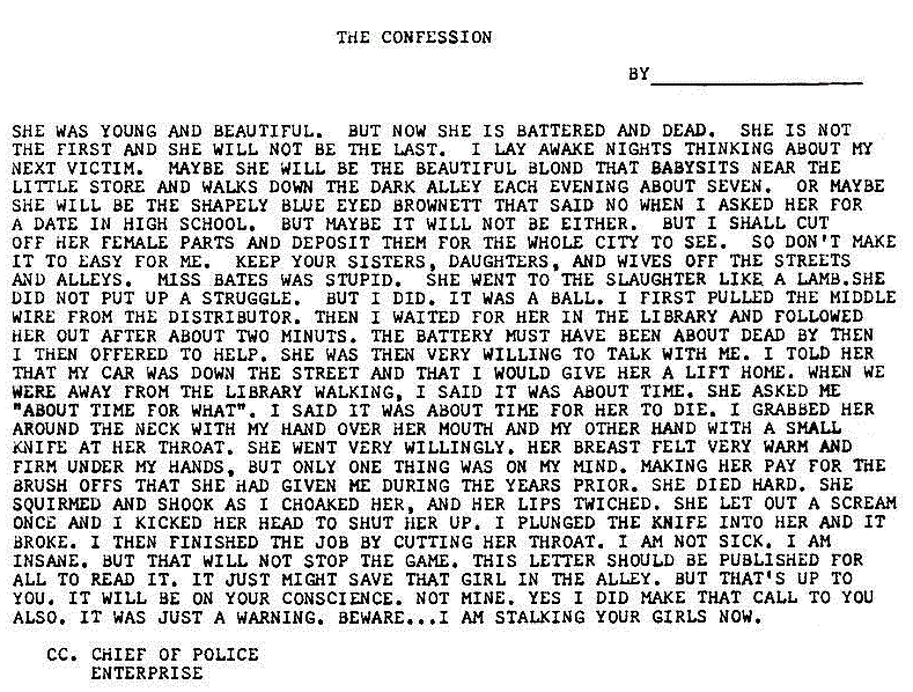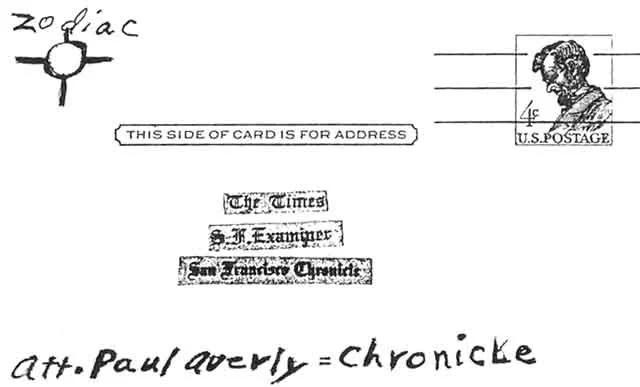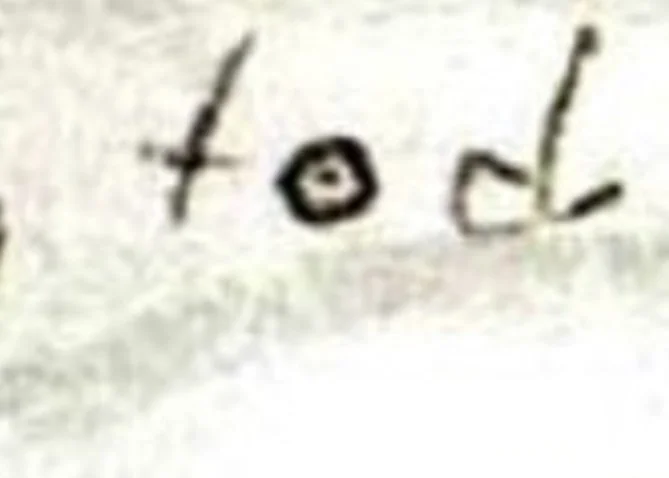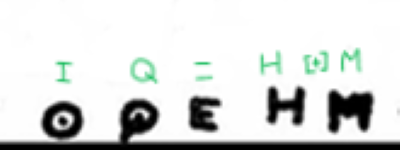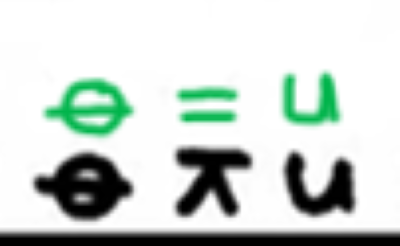The z408 Cipher
Blog Post #8
Just like the Zodiac Killer, the author of “THE CONFESSION” proved he was a killer by giving details unknown to the public.
And like the envelope THE CONFESSION was received in, the back of the “Sierra Club” Card has an “attention” section involving a local newspaper (see image below). . . . If it was not typed by the Zodiac Killer, why did the author of THE CONFESSION never “kill and tell” again? It is one of the most theatrical letters ever written by a killer—and the murder of Cheri Jo Bates is like something out of a horror movie; someone with this much flare for the macabre doesn’t lose their taste for it after one drink.
The back of the Sierra Club Card self-indicates that it was mailed out by the Zodiac Killer. It also features the bizarre equation “Paul averly = ChronicLe.” In other words, it shows that names and/or letters have values.
The Bizarre Equation has two Conspicuous Ls: The L in “ChronicLe” is inappropriately capitalized, while the L in “averly” shouldn’t exist (averly is a misspelling of Avery—a former journalist at the San Francisco Chronicle). . . . Counterintuitively, these Conspicuous Ls are what make the equation work.
P for Paul is the sixteenth letter of the alphabet, A for averly is the first letter of the alphabet, and L for the Conspicuous Ls is the twelfth letter of the alphabet; 16 - 1 - 12 (that is, P minus A minus L) = 3, and the third letter of the alphabet is C as in “ChronicLe.” And so, the Bizarre Equation represents C = C and/or 3 = 3.
The fact that the L should be taken out of Paul averly works as a metaphor for subtracting L (or 12). In other words, the L in averly tells you to subtract. . . . Synchronously, taking the L out of Paul averly turns the Bizarre Equation into “Paul avery = ChronicLe” which works because Paul avery is nine letters and so is ChronicLe.
Unsurprisingly, the Bizarre Equation is not the only strange feature there on the back of the Sierra Club Card; it was mailed out to the San Francisco Chronicle, yet it also includes “The Times” and “S.F. Examiner” in its address area. . . . This Triple Address of
"The Times
“S.F. Examiner
“San Francisco Chronicle”
is 39 letters and 2 punctuation marks; 39 - 2 = 37 as in the Theme of 37 described in Blog Post #3. . . . While subtracting the [2] punctuation marks may seem like an arbitrary thing to do, it’s a common practice in cryptography—and it was done in the z408 and z340 ciphers (that is, neither of their solutions have punctuation marks).
The top-left of this image features the cross-and-circle insignia for Zodiac brand watches—but it’s modified so that its lines don’t make a plus sign [+]. And so, the Zodiac Killer is telling you “Don’t Add.”
(By contrast, this “Don’t Add” interpretation supports the idea that the cross in the insignia symbolizes a plus sign—as explained at the end of Blog Post #7 aka The My Name Is cipher.)
The “Don’t Add” Insignia has four short lines (reaching out from the circle)—and each could symbolize a minus sign [-]. One of the Four Symbolic Minus Signs overlaps with the letter D (from “Zodiac”), the fourth letter of the alphabet—and that synchronicity could be meant as a statement: “Subtract.”
Much more straightforwardly, the back of the Sierra Club Card features the statement “THIS SIDE OF CARD IS FOR ADDRESS” as many postcards do. It is twenty-six characters—and so, it fits with the Theme of 26 aka the Z-26 Theme described throughout this website. . . . Of course, a THIS SIDE OF CARD IS FOR ADDRESS section is a rather normal feature for a postcard—but that doesn’t mean it can’t serve a hidden purpose in one mailed out by (what some people would call) an apopheniac.
Apophenia is a word I don’t like; it means “the tendency to perceive meaningful connections between unrelated things.” My question is: Who decides what things are unrelated? As circumstances change, things that may have seemed unrelated could prove to be strongly connected.
Things like electricity and magnetism.
Because my work on the Zodiac Killer case involves unusual connections, I have been accused of having apophenia. My response to the person who mocked me is: The Zodiac Killer is the one who had what you call apophenia; all I’m doing is describing the connections he saw. . . . Ross Sullivan had schizophrenia, which ironically has a strong connection with (what some people call) apophenia.
And so, we have to look at written language through his eyes—or else the Zodiac Killer case may remain unsolved forever.
The dot of a lowercase I has the same physical form as a period—therefore, they can be the same thing in the eyes of Ross Sullivan. And so, “Att. Paul averly = ChronicLe” has three non-letters: a period, an equal sign, and the dot above a lowercase I.
As with the Triple Address, the non-letters are meant to be subtracted from the letters—but the letters have two different values because of the Subtracting the L Metaphor described earlier. In other words, Att. Paul averly = Chronicle is both twenty-two and twenty-one letters because the L in averly is there—yet symbolically, it is also not there. . . . And so, the solution has two values: 22 (letters) - 3 (non-letters) = 19, and 21 (letters) - 3 (non-letters) = 18. . . . The eighteenth letter of the alphabet is R, and the nineteenth is S.
Ultimately, the Att. Line = RS, the initials for Ross Sullivan—just as the Triple Address = Theme of 37; as described in Blog Post #3, the Theme of 37 is based on how the numeric value of RS = 37 (that is, 18 + 19 = 37).
“DAILY ENTERPRISE RIVERSIDE CALIF” is twenty-nine letters—all uppercase except for the I’s; subtracting the dots above its four lowercase I’s (symbolic periods) would make twenty-five, which is the number of letters in Ross Mercer Stephen Sullivan. However, one of the dots is connected to its lowercase I, resulting in what looks like a matchstick. . . . As a matchstick looks nothing like a period, the Matchstick Dot is symbolically added back to the total. Now “DAILY ENTERPRISE RIVERSIDE CALIF” has a symbolic value of twenty-six, and the twenty-sixth letter of the alphabet is Z as in Zodiac. (By the way, the first R in “RIVERSIDE” is so prominent because R is the first letter in Ross.)
“ATTN: CRIME” is nine letters (the ninth letter of the alphabet is I, which is also a pronoun)—all capital except for its I. Its colon represents two periods because it has the same physical form as two periods. . . . And so—nine letters minus its three symbolic periods (the dot above its lowercase I and the two dots that make up its colon) equals six, which the number of letters in Zodiac.
The first example of this Subtracting the Periods code was described near the end of Blog Post #7 aka The “My Name Is” Cipher. Now it becomes a theme.
According to Wikipedia, “steganography” is the practice of representing information within another message or physical object, in such a manner that the presence of the information is not evident to human inspection.” In other words, steganography is the cousin of cryptography; instead of using symbols to make a message, it hides the fact that a message (or other information) even exists.
To make a long story short, the z408 cipher combines cryptography with steganography. In other words, the longstanding solution to the z408 cipher is only one in a series of steps to fully interpreting it. . . . Many of those steps have already been done in earlier Blog Posts on this website.
Some of the z408 cipher’s most thematically significant symbol-letter solutions involve the letter E.
Eye (image) = E because eye begins with E.
(Do you remember the O/Eye Image from the Desktop Poem? It is no coincidence that an eye image shows up as a symbol in the z408 cipher.)
9 = E because nine ends with E (among other reasons that are indirectly covered in the second paragraph below).
Relatedly, a syllogism states that if A = B, and C = B, then A = C.
Therefore, if Eye (image) = E and 9 = E, then Eye (image) = 9. And that works as another example of how Eye Images = Letter I’s (as described in Blog Posts #3 and #4) because eye the sensory organ is a homophone for the letter I, which is the ninth letter of the alphabet (as well as the ninth letter in Ross Sullivan).
A syllogism also states that if A = B, and A = C, then B = C. And if B = D, and E = D, then B = E.
Therefore—if Eye (image) = E, and Eye (image) = I, then E = I. And E = S (another of the z408 cipher’s symbol-letter solutions) can become I = S as in Sullivan.
N = E is an extension of 9 = E because nine begins with the letter N and ends with E. But let’s give the analysis a new dimension: N is the fourteenth letter of the alphabet, while E is the fifth—and the digits in 14 add up to 5 (because 1 + 4 = 5).
Now take for instance E = S again (the arithmetic for which happens to be identical to that of N = E): S is the nineteenth letter of the alphabet, nineteen begins with the letter N, N is the fourteenth letter of the alphabet, the digits in 14 add up to 5 (because 1 + 4 = 5), and the fifth letter of the alphabet is E.
These kinds of arithmetic equivalences occur in tens of symbol-letter solutions throughout the z408 cipher; they are likely based on a game called Krypto in which six numeric cards are dealt out, and the goal is to arithmetically reach one card using the other five. . . . Krypto came out in 1963, well before the murder of Cheri Jo Bates or the canonical Zodiac Killer murders—and the name of the game is nearly identical to the first six letters in cryptology.
As explained in Blog Post #4, E = Z in a perfect reversal of cryptography’s Z-is-the-least-common-letter logic because E is the most common letter (in terms of standard English spelling). In other words, cryptography is symbolically turned on its head all over every page.
And E = E is a balancing-opposite to Z = E; E is still the most common letter even though it is also represented by the least common letter. In other words, cryptography’s basic logic can still apply—and that’s why the z408 cipher was solved by hobbyists.
Now let’s look at some symbol-letter solutions with seemingly obvious factors behind their selection—including easy arithmetic. (By the way, the list below could be much longer.)
Y = U because the pronunciation of U begins with a Y sound.
A = W because A is the first letter of the alphabet, and the pronunciation of one begins with a W sound.
Anchor = O because anchor begins with the letter A, A is the first letter of the alphabet, and the spelling of one begins with O. The same logic works as a statement for why the Asymmetric Anchor is the thirteenth and final symbol in the sequence for the “My name is” cipher; when added to the surname, O as in one is what turns Ross Sullivan into thirteen letters.
L = T because L is the twelfth letter of the alphabet, and twelve begins with the letter T.
H = T because H is the eighth letter of the alphabet, and the last letter in eight is T.
Dot = T because T is the last letter in dot.
Backwards L = A because L is the twelfth letter of the alphabet, 2 – 1 (the second digit in 12 minus the first) = 1, and the first letter of the alphabet is A.
Q = F because Q is the seventeenth letter of the alphabet, 7 – 1 (the second digit in 17 minus the first) = 6, and the sixth letter of the alphabet is F.
Now let’s look at some symbol-letter solutions that may have more complex factors behind their selection—including more complex arithmetic. (Again, the following list could be much longer.)
Backwards F = D because F is the sixth letter of the alphabet, and the mirror image of 6 (as the Backwards F representing it is a mirror image) resembles a lowercase D.
Backwards E = C because Backwards E resembles the number 3, and the third letter of the alphabet is C. (The same analysis would still apply if the Backwards E actually is the number 3.)
6 or G = A because the symbol resembles both a 6 and a G; G is the seventh letter of the alphabet, 7 – 6 (the numeric position of G minus the 6 that the symbol also resembles) = 1, and the first letter of the alphabet is A.
J = F because J is the tenth letter of the alphabet, while its pronunciation begins with a soft G sound; G is the seventh letter of the alphabet, 7 – 1 – 0 (in other words, the numeric position of G minus the digits in 10, which is the numeric position of J) = 6, and the sixth letter of the alphabet is F.
I = T because I is the Roman numeral for 1, a homophone for eye the sensory organ, and the ninth letter of the alphabet; nine begins with N, the fourteenth letter of the alphabet, 14 + 5 (the numeric position of N plus the numeric position of E, which is the first letter in eye) + 1 (because it is represented by I in Roman numerals) = 20, and the twentieth letter of the alphabet is T.
Downwards K = P because K is the eleventh letter of the alphabet, while the number 11 turned ninety degrees clockwise (as the Downwards K representing it is a regular K turned ninety degrees clockwise) looks like an equal sign [=]; the word equal begins with E, E is the fifth letter of the alphabet, 5 + 11 (in other words, E plus K) = 16, and the sixteenth letter of the alphabet is P.
Now let’s look at some more letter-symbol solutions that may have thematic importance to other analyses throughout this website. (Again, the following list could be much longer.)
S = A works as an analogy for how S is the first letter in Sullivan, while A is the first letter of the alphabet.
O = N because O and N are the first and last letters in O’Sullivan, which features in the My Name Is cipher’s solution: RossOSullivan.
R = G because G is the seventh letter of the alphabet, seven begins with the letter S, and S coupled with the R symbol makes RS: the initials for Ross Sullivan.
Cross = E because the last four letters of cross spell “Ross”; Ross begins with R, R is the eighteenth letter of the alphabet, and eighteen begins with the letter E.
(As a reminder, the alphabet-number code assigns a number to every letter based on its position in the alphabet—A-1, B-2, C-2, etc.)
Backwards Q = M because M is the first letter in Mercer (Ross Sullivan’s first of two middle names), while Q is the seventeenth letter of the alphabet; 17 backwards (like the Q that represents it) is 71, and 71 is the total numeric value of the alphabet-number characters for “Ross.” That is, 18 + 15 + 19 + 19 (from R-18, O-15, S-19, and another S-19) = 71. And so, Backwards Q = M is symbolically equivalent to Ross = Mercer or Ross = Me as in “= “Me - 37” from “The Exorcist” Letter.
F = S because F is the sixth letter of the alphabet, while S is the nineteenth; 6 + 19 = 25, and twenty-five is the total number of letters in Ross Mercer Stephen Sullivan.
And as F is the sixth letter of the alphabet, while six begins with the letter S, F = S could be equivalent to S = S—which in turn could represent the double S in Ross and/or RMSS: the initials for Ross Mercer Stephen Sullivan.
B = L because B is the second letter of the alphabet, and a double L occurs in Sullivan.
Saturn = H seems to have been a precursor to the Strikethrough Skeleton; Saturn and skeleton both begin with S and end with N—like Sullivan. And so, Saturn = H is equivalent to Sullivan = H.
Moreover, Saturn has six letters, and so does Zodiac. . . . But while we’re counting letters, the twenty-five letters in Ross Mercer Stephen Sullivan become twenty-six when the Irish O is restored to Sullivan as is done in the RossOSullivan solution to the My Name Is cipher (fully detailed in Blog Post #7). In other words, putting the Irish O back in the surname symbolically turns Ross Mercer Stephen Sullivan into Z as in Zodiac.
Backwards K = I occurs exactly nine times throughout the z408 cipher; each representing the letter I, the nine Backwards Ks work as yet another reference to how I is the ninth letter of the alphabet—in other words, I-9 of the alphabet-number code.
Finally, P = I because together they spell pi—which is a homophone for pie, the dessert. In other words, P = I is a reference to the Pi Sign Puzzle as well as the PIE or DIE dilemma described in Blog Post #4.
We now have enough context to start interpreting the z408 Extras (the eighteen “extra” characters at the end of the z408 cipher).
The thirteenth symbol in the z408 Extras is what I call the Scribbly M because of its untidy appearance. But it is an M nonetheless, and it thematically plays into the alphabet-number code because M is the thirteenth letter of the alphabet. . . . Moreover—being both the thirteenth letter of the alphabet and the thirteenth symbol in the z408 Extras, the Scribbly M could represent Z for Zodiac because 13 + 13 = 26, and the twenty-sixth letter of the alphabet is Z.
Additionally, the Scribbly M makes a Thirteenth Symbol-Thirteenth Letter theme because the thirteenth and final symbol in the “My Name Is” cipher is also the letter M. . . . And if the Large Lowercase Cursive M from the Letter to Joseph Bates has hidden significance as Blog Post #4 argues, then the Scribbly M makes an Important Strange-Looking M theme.
The z408 Extras’ ninth symbol is an eye image, and it plays into the alphabet-number code as well. Can you tell why?
And can you tell why the z408 Extras’ first symbol is also an eye image?
Because eye the sensory organ is a homophone for the letter I, which is the Roman numeral for 1. . . . It is also the ninth letter of the alphabet, to answer the first question.
I’ve analyzed all the symbols in the z408 Extras, and none of them seem to have been selected randomly. . . . Let’s cherry pick the most interesting ones.
The third symbol is a capital E because the mirror image of E resembles the number three.
The fifth symbol is a Backwards R because 5 (the numeric position of the symbol) + 2 (the numeric position of B for “backwards”) + 18 (the numeric position of R) = 25, and twenty-five is the number of letters in Ross Mercer Stephen Sullivan.
The sixth symbol is a triangle because triangle begins with T; 20 (the numeric position of T) + 6 (the numeric position of the symbol) = 26, and the twenty-sixth letter of the alphabet is Z as in Zodiac.
The eighth symbol is the letter I because there are eight letters in Sullivan: “I = 8 (Letters).”
The tenth symbol is a Backwards Q because the number 10 can be visually rearranged into a Backwards Q (or a regular Q for that matter).
The eleventh symbol is an E because E is the first letter in eleven.
The fourteenth symbol is Saturn because Saturn ends with the letter N, and N is the fourteenth letter of the alphabet.
The seventeenth symbol is I because 1 + 7 (the digits in 17 added to each other) = 8, which is the number of letters in Sullivan. Another example of “I = 8 (Letters).”
As a refresher, the symbol selection behind Downwards K = P involves an equal sign (because K is the eleventh letter of the alphabet, and the number 11 turned ninety degrees clockwise [like the Downwards K that represents it] looks like an equal sign [=]). And so, the Downwards K in the z408 Extras could represent an equivalence between its bookending symbols. In other words, it could be the equal sign in a Saturn = U equation. . . . Or perhaps more symbols are involved in this Very, Very Strange Equation.
An eye image and a Backwards Q occur at roughly the center of the z408 Extras—and being side by side, they could represent IQ or intelligence quotient. . . . As a refresher, Backwards Q works as a reference to the name Ross (because Q is the seventeenth letter of the alphabet, 17 backwards [like the Backwards Q that represents it] is 71, and 71 is the total numeric value for the alphabet-number characters in “Ross”).
In other words, the Backwards Q and the eye image to its left (in the z408 Extras) could mean that Ross is calling himself the measure of intelligence (IQ)—in other words, the smartest person.
And six other symbols could mean that (Ross) Sullivan is again calling himself the measure of intelligence. . . . Check out the image below. Start from the only symbol in the top row—then follow the arrows.
Eye-k-i-u = Saturn becomes IQ = Saturn; Saturn begins with S and ends with N like Sullivan. In effect, Ross Sullivan is reiterating that he is the measure of intelligence.
But he thought someone else was (or would be) his intellectual equal: me. As in, me—the essayist who would figure this stuff out.
The second row’s eye image couples with the letter I to its left and symbolizes two eyes watching me—as I solve the sequence going in the opposite direction: I Q Equals H (plus) M. . . . The sequence ultimately says IQ = You (which in this case is me). Can you tell why?
The numeric position of H plus the numeric position of M equals the numeric position of U (because 8 + 13 = 21), and the letter U is a homophone for you, the pronoun. In turn, the Scribbly M becomes a metaphor for how M does not neatly represent Mercer: Scribbly M = Not Mercer; it is part of U.
By the way, the z408 cipher’s M = H solution works as a reference to how the two letter-symbols combine in the IQ = You sequence (image below).
In addition to a K sound between them, the words “I” and “you” make up the pronunciation of IQ. And so—representing a measure of intelligence, Eye (image)-Backwards Q is a pronunciation-based metaphor for how Ross Sullivan believes he and I have equal measures of intelligence (because I wouldn’t have been able to solve his sequence otherwise).
To end on an understatement, the z408 cipher seems to be full of hidden information. In other words, it has many examples of steganography. It has so many, in fact, that this Blog Post could be an entire book.
One more thing: The z408 Extras contain the solutions W = E and U = I, and they are symbolic of “we” and “I am You.” In other words, Ross is reiterating and reiterating that he and I are of equal intelligence. Or maybe he’s even saying that he and I are one person—an “I am You” theme.
Saturn is (Ross) Sullivan, and “U” is me. . . . But there is a difference between me and Ross: I am a pacifist, and he was a murderer.

